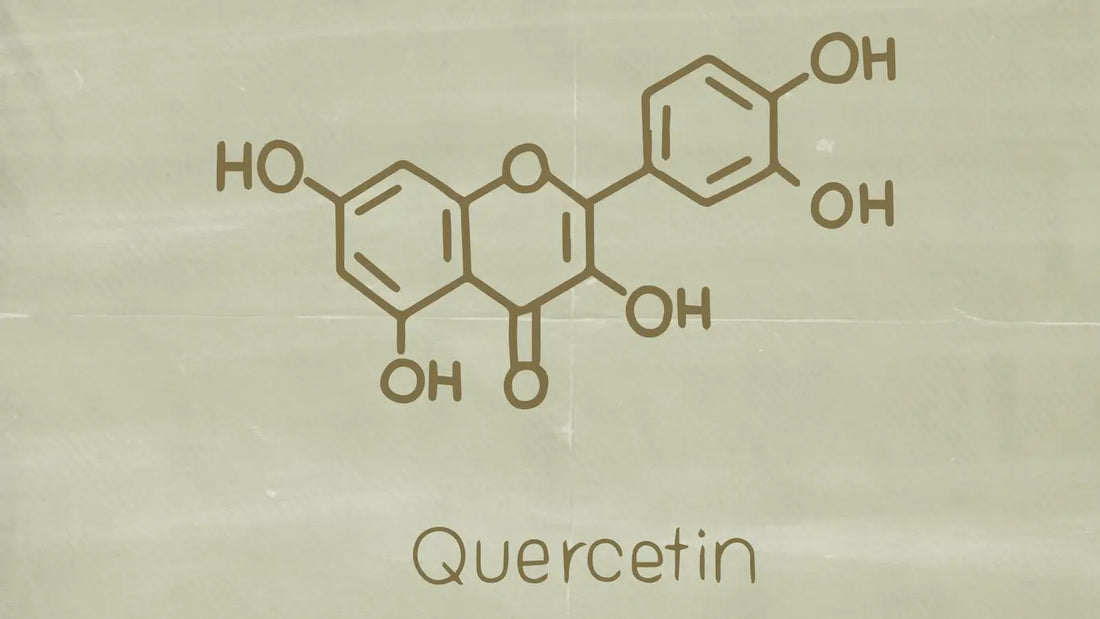
Quercetin: Benefits & Ingredient Information
Share
Quercetin benefits are often discussed in the context of antioxidant support. Quercetin is a plant-derived flavonol found in many everyday foods and included in Relief for its role in helping to reduce free radicals formed in the body. This article forms part of our Ingredient Glossary to support transparent, evidence-aware choices. It is general information only and not a substitute for medical advice.
What is Quercetin?
Quercetin is a polyphenolic flavonol naturally present in fruits, vegetables and tea. You will find it in onions, apples, berries, capers and green or black tea. In supplements it commonly appears as quercetin dihydrate. Quercetin contributes to general health via antioxidant activity, supporting the body’s defences against free radical damage. In Relief, quercetin dihydrate is included alongside a range of botanicals within a plant-based, TGA-listed formulation.
Where Quercetin is Found in Food
Foods high in quercetin include red and yellow onions, apples (particularly the skin), capers, kale, rocket, blueberries, cranberries and tea. A varied diet remains the best foundation for overall wellbeing. Supplements are intended to complement, not replace, balanced nutrition.
How Quercetin Works: All About Antioxidants
Everyday metabolism, environmental exposure and intense exercise can generate free radicals. In excess, these unstable molecules contribute to oxidative stress. Antioxidants such as quercetin can donate electrons to help stabilise free radicals, supporting the body’s antioxidant network and helping to reduce free radical damage. Put simply, quercetin participates in the normal checks and balances that keep oxidative processes in line. Research has also explored how quercetin interacts within broader dietary patterns (for example, green tea and quercetin both contain polyphenols), but antioxidant support remains the most appropriate way to describe its role.
Quercetin in Relief: Why We Include It
Relief combines quercetin with herbs traditionally used in Western and Chinese herbal medicine, including turmeric, ginger, lemon balm, green tea, Dong Quai and Panax notoginseng. In this context, quercetin supports antioxidant defences and general health and wellbeing, complementing botanicals that are traditionally used for menstrual comfort, digestive support and emotional balance. Explore Relief.
What the Research Says
Antioxidant capacity: Human and laboratory studies have examined quercetin’s ability to scavenge free radicals and influence markers of oxidative status. Overall, findings support its role as a dietary antioxidant while recognising results vary by dose, matrix and population.
Exercise and recovery: Studies in healthy adults have investigated associations between quercetin intake, oxidative stress markers and general wellbeing in exercise settings. Outcomes are mixed, but they contribute to the broader picture of quercetin as part of an antioxidant-rich diet.
Inflammation markers (general): Research has explored relationships between quercetin intake and selected biomarkers linked to the body’s inflammatory responses. These findings are exploratory and should be interpreted cautiously; they do not translate to disease claims.
We prioritise systematic reviews and randomised trials when available and avoid drawing conclusions beyond the data.
Quercetin FAQs
Is quercetin natural?
Yes. Quercetin is a naturally occurring plant flavonol found in common foods such as onions, apples, berries and tea.
Can I get enough quercetin from food alone?
Many people obtain quercetin from a varied diet rich in fruit, vegetables and tea. Supplements are used when someone prefers a consistent, labelled intake to support antioxidant defences.
Does quercetin have side effects?
Quercetin side effects are uncommon at standard supplemental intakes, though mild digestive upset has been reported in some individuals. Always read the label and follow the directions for use.
Who should not take quercetin?
If you are pregnant, breastfeeding, under 12 years of age, or taking prescription medicines, speak to your health professional before use. This product is intended for adults and teens 12+ as directed.
Does quercetin help with period pain?
In Relief, quercetin is included for antioxidant support. Relief’s herbal ingredients are traditionally used to relieve menstruation pain and support digestive comfort; we do not ascribe those traditional indications to quercetin itself.
How long does it take for quercetin to work?
Antioxidant support is best considered over time as part of daily routines and dietary patterns rather than as an immediate effect. Consistent use as directed is recommended.
References and Further Reading
Recent peer-reviewed reviews on quercetin and antioxidant activity; methodological papers on dietary flavonoids and oxidative stress; authoritative nutrition texts on polyphenols.
• Dietary quercetin and kaempferol: bioavailability and metabolism (review, 2019).
• EFSA scientific opinion on quercetin-related health claims (oxidative damage protection), 2011.
• Quercetin supplementation and recovery after exercise-induced muscle damage (systematic review & meta-analysis, 2023).
• Effects of quercetin on lipid profiles and C-reactive protein (meta-analysis, 2020).
• Antioxidant supplements and endurance exercise: context for oxidative stress and recovery (review, 2020).
• Overview of quercetin’s biological importance, including antioxidant mechanisms (review, 2016).
• Quercetin—secondary metabolite with antioxidant and related activities (systematic review, 2024).
• Flavonoids (Linus Pauling Institute) — educational overview with USDA database pointers.
• Free radicals and antioxidant defences (general antioxidant overview, 2025) — context for how antioxidants like quercetin act.
• Quercetin, inflammation and immunity (review, 2016) — cautious discussion of biomarker research.
General Advice and Cautions
Always read the label and follow the directions for use. If symptoms persist, talk to your health professional. If you are pregnant, breastfeeding or taking medicines, seek professional advice before use. For product details and common questions, see Relief FAQs.
